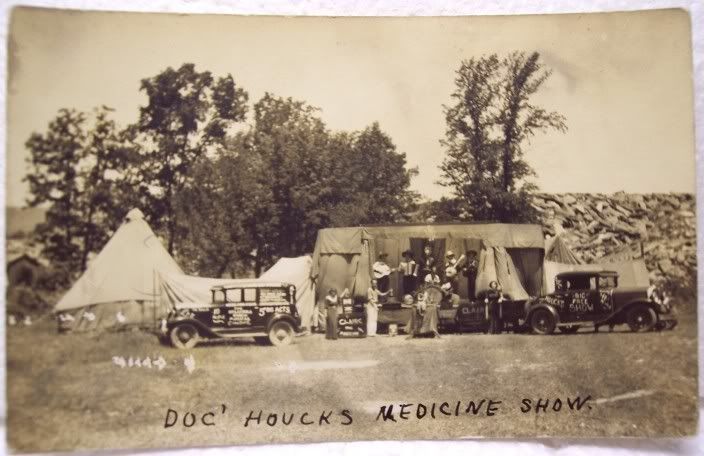Post some Houck's Panacea Counterstamps....
 savoyspecial
Posts: 7,322 ✭✭✭✭
savoyspecial
Posts: 7,322 ✭✭✭✭

Quarternut, tydye.....get to posting!
www.brunkauctions.com
0
 savoyspecial
Posts: 7,322 ✭✭✭✭
savoyspecial
Posts: 7,322 ✭✭✭✭

www.brunkauctions.com
Comments
I don't have one to show, but.....WOW! Where did you get that picture? Obviously "Doc Houck's Medicine Show" (as imaged) was comprised of his decendants. What more can you tell us about the photograph? I did get the chance to recently catalog one for next month's Long Beach auction though. Here's that description:
'Houck's Panacea' Countermark on 1831 Bust Half, HT-141
Circa 1836 "Houck's Panacea" Counterstamp on a Bust Half. HT-141, Brunk H-779. Baltimore, Maryland "Houck's Panacea" countermarked coins are fascinating. Unfortunately for collectors, they are also in short supply. Specimens are found most commonly--and we use that term lightly--on U.S. Bust half dollars dated 1836 or earlier. Less than 100 fifty cent versions are believed to be extant in all grades, with far fewer found on Bust quarters, dollars, and a smattering of foreign coins. A contemporary advertisement discovered by noted researcher Gregory Brunk provides insight into the enigmatic nature of Houck's Panacea. According to the ad, the potion was "prepared solely from vegetable matter" and sold for $1.50 per bottle, which was no pittance in the 1830s. In fact, after adjusting for various economic factors, a bottle would have been the equivalent of approximately $30 today. Panacea--also the name of the Greek goddess of healing--is a medical term for a "cure-all" remedy. Jacob Houck claimed that his concoction could be "taken with perfect safety by all ages and in all diseases." It is no wonder that it was safe, considering that it was nothing more than "vegetable matter." His ad claimed that Houck's Panacea could cure anything from gas to yellow fever to gout. The Food and Drug Administration would have had a field day with Mr. Houck!
A VF 1831 half dollar, O-108, is the host coin for this example. The countermark grades XF or better. Gunmetal-gray surfaces reveal subtle traces of green and cobalt toning when viewed in angled lighting. A minor rim bump at 9 o'clock on the obverse is noted for the sake of full disclosure.
Collector since 1976. On the CU forums here since 2001.
certainly makes it 20th century doesnt it?
www.brunkauctions.com
As Dennis said, must be from a descendent.
Per request, here is a picture of my original bottle which contained that antebellum elixer...
And my Bust Quarter (one of only 4 known) with the counterstamp...
Along with a picture of the other known 1818 Bust Quarter with this countermark from the Pittman sale...
Now a little background...
Houcks PANACEA , the famous "snake medicine" of it's day. Here is a little more background from an article I published in the John Reich Journal for December 2006 (Vol. 17/3 pg. 28).
HOUCKS / PANACEA / BALTIMORE
The coins found with this countermark are one of the most popular and sought after counterstamps, as they are part of the “Hard Times” token series and are generally found on Bust Half Dollars.
Dr. Jacob Houck came to Baltimore Maryland in 1828 and opened a dry goods business at 121 West Baltimore St. It wasn’t until 1834 that he began selling “Botanic Panacea” for $1.50 a bottle and advertised in the 1835 to 1842 business directories.
Proported to cure almost all ills including: Dyspepsin, loss of appetite, indigestion, inflamation of the stomach, heartburn, diarrhea, dysentory or flux, piles, fistola, obstructed monstruation, ague and fever, bilious or remittent fever, typhus fever, scarlet fever, small pox, St. Anthoney's fire, asthma, pleurisy, measeles, yellow fever, wind on the stomach or bowels, cholera morbus, consuption, influenza, colds, coughs, inflammation of the chest, palsy, gout, rheumatism, whooping cough, croup, dropsy, rickets, diseases of the liver, jaundice, difficulty of making urine, hysterics, mercurial and venereal diseases, ulcers, sores, etc. (The main ingredients were most likely alcohol or opium, cocaine or some such other "cure")
This Panacea was sold at various business address locations including 16 Hanover St. (which was listed in a full page ad in Matchett’s Baltimore Director in 1842) up until the 1850’s. Henry T. Houck became proprietor of the firm in 1851 and in later years probably licensed it for others to sell, as there is an 1855 advertisement in a Nashville Tennessee directory by a A.G. Goodlet for “Houck’s Improved Panacea & Goodlet’s Vegetable Lineament” listed at No. 29 1/2 Cherry St. Nashville Tennessee.
QN
Go to Early United States Coins - to order the New "Early United States Half Dollar Vol. 1 / 1794-1807" book or the 1st new Bust Quarter book!
I could be wrong though as my area of knowledge is mostly post War. That would likely be 4th generation if my time is correct.
- Marcus Tullius Cicero, 106-43 BC
-Randy Newman
Houck's Panacea Popular Counterstamp 1835 Half Dollar
QN
Go to Early United States Coins - to order the New "Early United States Half Dollar Vol. 1 / 1794-1807" book or the 1st new Bust Quarter book!
www.brunkauctions.com
I really like these
Stefanie
.
CoinsAreFun Toned Silver Eagle Proof Album
.
Gallery Mint Museum, Ron Landis& Joe Rust, The beginnings of the Golden Dollar
.
More CoinsAreFun Pictorials NGC FOR SALE
njcc
<< <i>Nice!
I really like these
Stefanie >>
1835 Capped Bust Quarter "Houck's Panacea Baltimore" Maryland, Counterstamp, HT-140, Rarity-7.
This is a newly discovered date as up until now none have been known dated beyond 1819 on a capped bust quarter.
<< <i>Nice find Broadstruck! >>
BaseballAbs, Thanks it's the first quarter I've ever seen available and pouched on it fast!
Keeper of the VAM Catalog • Professional Coin Imaging • Prime Number Set • World Coins in Early America • British Trade Dollars • Variety Attribution
<< <i>Wow, new date! Congrats on the newp! >>
Thanks Messydesk, I was thrilled to when I saw it